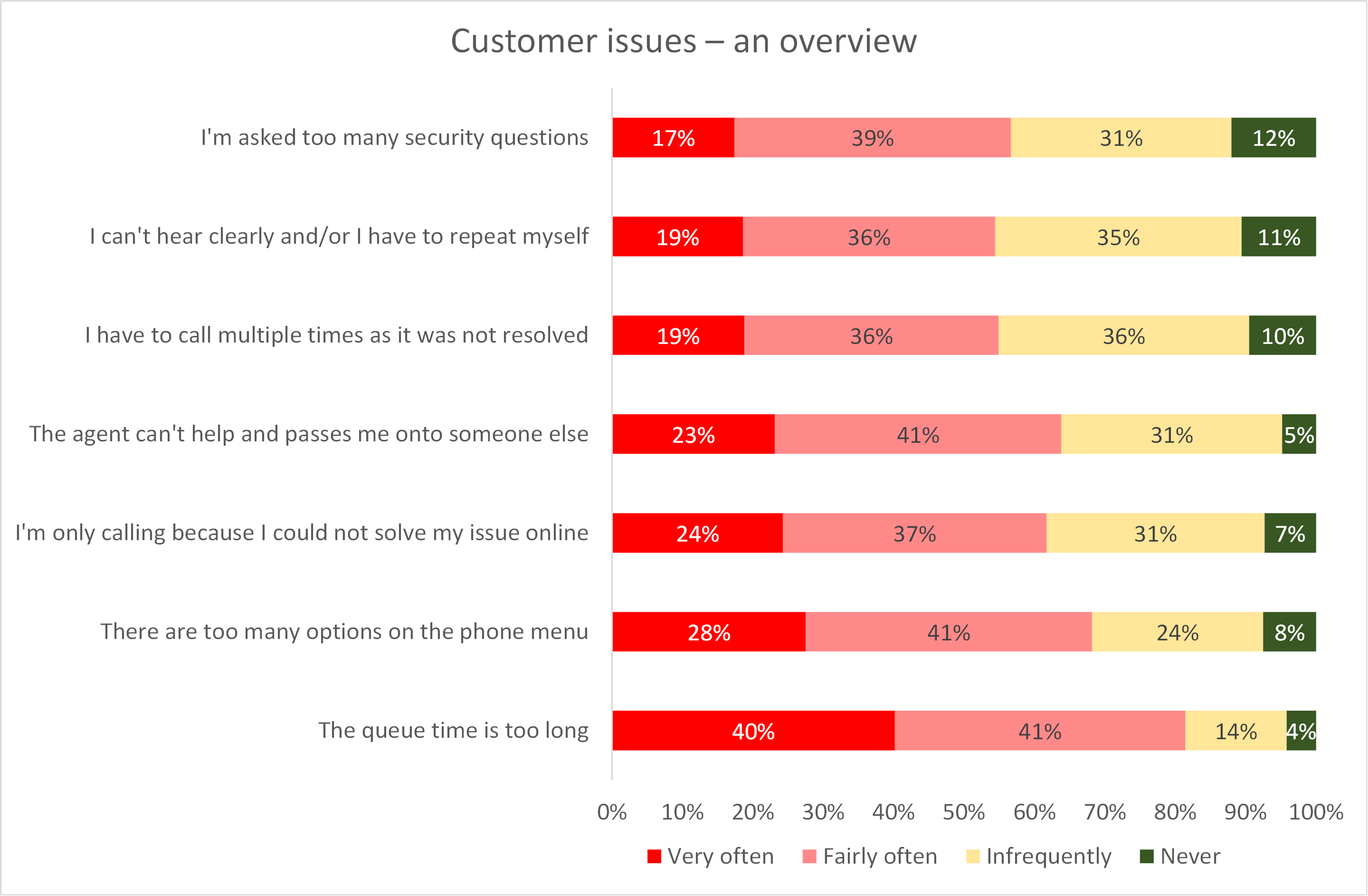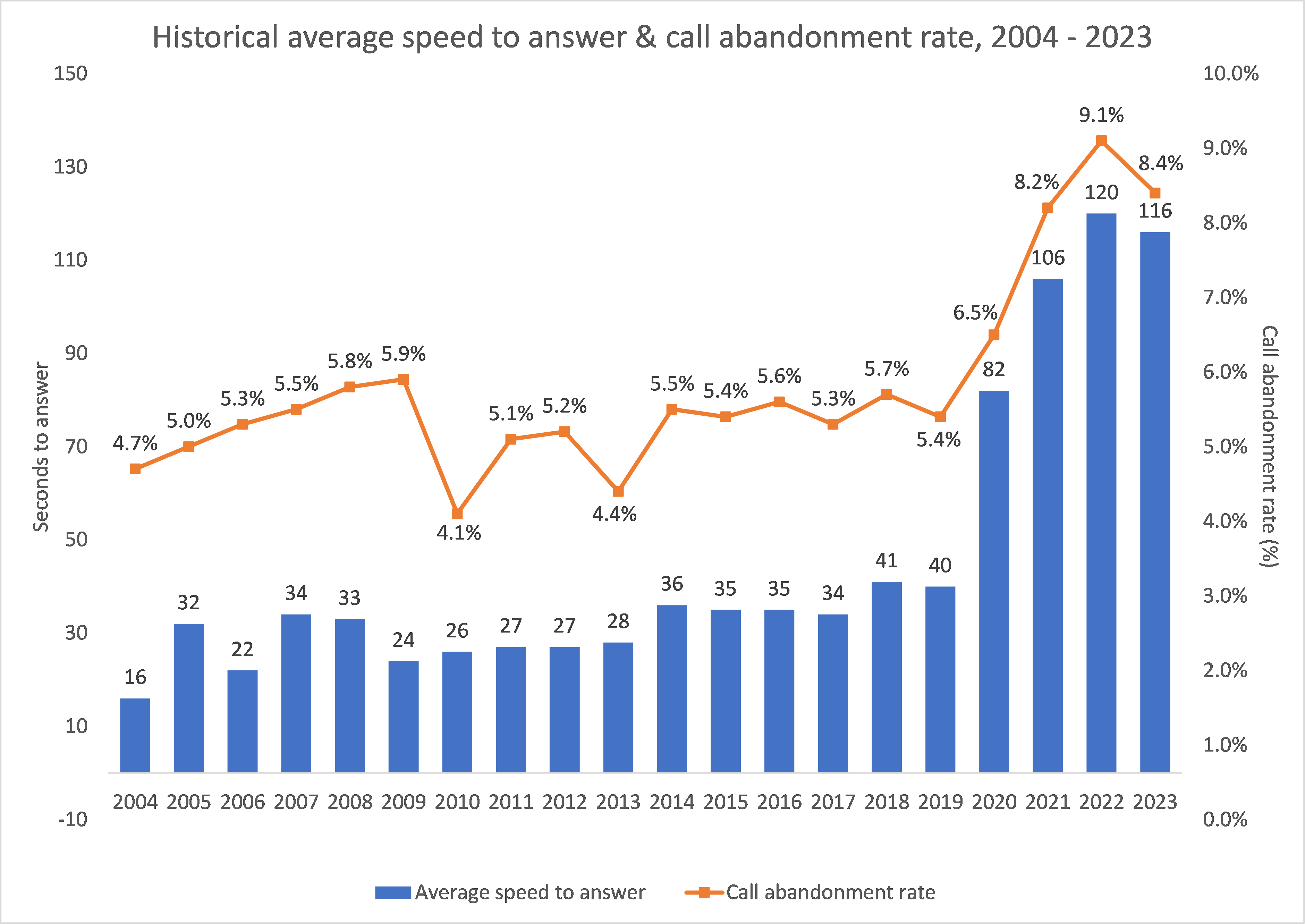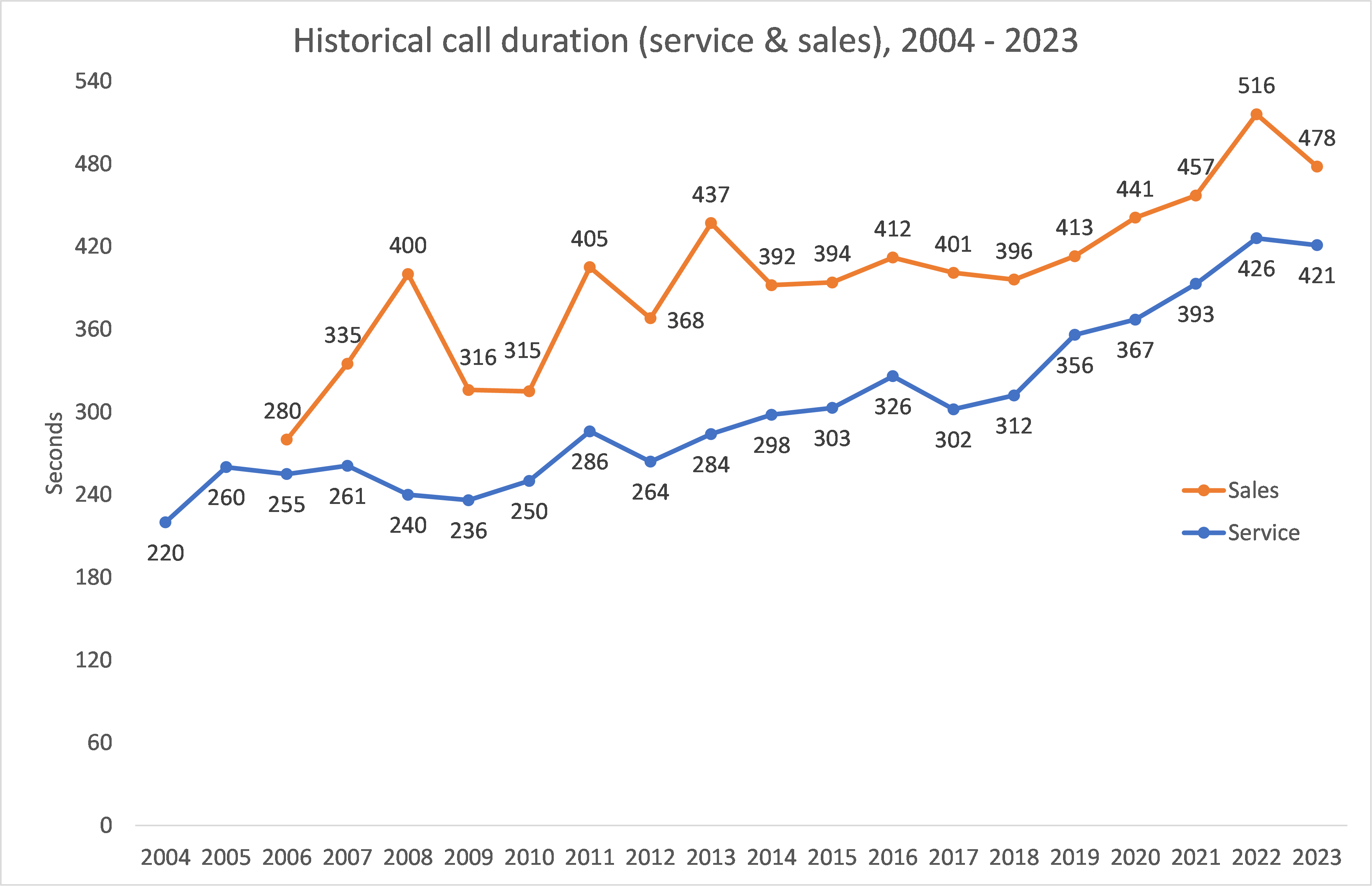How to cut call lengths without damaging customer experience
)
Last month, we wrote about what UK customers say they most value in a contact centre interaction, with first-contact resolution and short queue times being the factors that most influence customer satisfaction.
This month, we’ll look at what customers actually experience, and delve into one of the main challenges to short queue times: excessive call durations.
1,000 UK customers were asked about their experiences contacting businesses. The general view is that they hit roadblocks fairly often.
The standout finding – which won’t come as a surprise – is that 81% of survey respondents felt that the queue time was too long, either “very often” or “fairly often”. This has become considerably worse in recent years and needs to be dealt with urgently.
Figure 1: Customer issues – an overview

Speed to answer plays a vital part in improving the customer experience, and also feeds into other performance measures such as call abandonment rate: obviously, the longer the queue, the more people will abandon the call.
The following chart shows historical figures for average speed to answer and call abandonment rate.
From 2009 onwards there has been a gradual increase in average speed to answer, with a huge uptick in 2020 and 2021 caused by pandemic-related working practices and an increase in demand experienced by some businesses. Despite a return to some sort of normality, speed to answer remains extremely high compared to the historical norm.
Call abandonment rate did not show any upward trend until the pandemic, but has tracked upwards, driven by speed to answer.
This is clear proof that customers are not overexaggerating their frequent experiences with long queue times.
It is also worth noting that customers’ perceptions of how long they have been queueing are far higher than reality: past ContactBabel UK research asked customers to estimate their typical wait time, which was reported to be 23 times higher than the actual industry average, showing that the effect of queue times on customer experience is exceptional.
Figure 2: Historical average speed to answer & call abandonment rate, 2004 - 2023

So what’s driving the increase in queue time and call abandonment rate?
The following chart shows the rise in average call durations seen over the past 20 years, driven in part by the increase in the complexity of calls as self-service handles more of the simpler customer queries.
Figure 3: Historical mean call duration (service & sales), 2004 - 2023

Some years ago, enlightened operations began to regard this metric with wariness, as a call which is cut short too quickly can often mean a worse experience for the customer (with lower revenues over time), lower first-call resolution rates (which increase costs in the long-term) and fewer cross-selling or upselling attempts being made.
However, increased call lengths mean increased costs and reduced agent availability, and businesses that keep a control on call duration also manage other metrics important to their customers, such as queue times and call abandonment rates.
Agents that are on calls obviously cannot also be answering new calls: therefore, queue times rise as call durations increase. There is no great appetite in the contact centre industry for massively increasing headcount to impact on queue lengths, so the answer lies elsewhere.
Most calls have a degree of inefficiency within them which can be addressed without damaging quality, outcome or customer experience. AI-enabled solutions have recently come to market which can make calls more efficient, without damaging customer experience, and we will look briefly at them here.
AI-enabled solutions can be applied not only to reduce any wasted or low-value time within the call, but also to provide richer content to customers and assist agents to do their job more efficiently and productively.
There are numerous reasons why a call can be long, and businesses should consider which parts of a call are necessary and which are not. The following elements of a typical call are considered:
- Customer identification and authentication (typically around 10% of the overall call time)
- Talk time (71%)
- Post-call wrap-up (19%).
AUTOMATED CUSTOMER AUTHENTICATION
Automated customer authentication not only reduces the threat from fraud, but also frees up significant time within a call which can be used to decrease call queues.
A mean average of 76% of inbound calls to UK contact centres require caller identity verification. This takes an average of 44 seconds per call, which is 10.5% of a typical call’s length (costing an average of 58p per call).
92% of these calls are authenticated by agents, with 8% carried out by touchtone IVR, 1% through speech recognition and somewhat less than 1% by voice biometrics (the total is greater than 100% as some interactions require more than one method to be used).
The estimated cost to the UK contact centre industry of manual customer authentication is around £2.2bn each year, yet this adds nothing to the customer experience. It also impacts negatively on agent engagement or productivity: an agent may spend half an hour or more of their shift doing the mundane and repetitive task of taking customers through security.
Having an AI-enabled voicebot rather than an agent take customers through security reduces costs while providing a similar level of customer identification to live agent authentication, and has real potential to improve both productivity and agent morale.
The security process remains the same as if it were a live agent taking these details, with the voicebot simply taking their place. If the voicebot detects undue levels of stress or anxiety, it can flag the call to the agent as potentially fraudulent and further security checks can then take place.
OPTIMISING TALK TIME
AI offers great opportunities for a reduction in talk time and therefore cost, without negatively impacting customer experience or outcomes.
Within calls, time and money can be wasted by:
- searching for the right information
- accessing multiple applications and screens
- repetition due to mishearing
- pauses for agents to type
- reading long terms and conditions to customers.
AI offers an opportunity to provide timely and effective support to every agent as necessary, actually within the call.
Finding the right information: AI can provide the agent with suggestions about next best action, pull up relevant information from the knowledge base, make suggestions based on customer history and sentiment about optimal cross-selling and upselling opportunities, and even the style of conversation that this customer may prefer.
Apart from cutting down on wasted time, this also has a positive impact on first-contact resolution and customer experience, and is of particular use to less experienced agents and for unfamiliar subject areas.
Accessing a single screen: Only 4% of UK contact centres report using a single agent desktop within a call, with 96% requiring their agents to navigate multiple screens and applications within the call, and 40% needing agents to handle four or more.
These multiple applications are often only loosely linked, which requires skilled and experienced agents to navigate, let alone to manage interaction with customers successfully at the same time.
Many contact centres still rely on information held in legacy systems, and agents use an average of 3.6 applications within a call, and 2.5 post-call, which leads to considerable amounts of time being spent – especially by inexperienced agents – trying to find the right information or input data on the correct screen.
AI-enabled desktop automation solutions can remove the need for agents to log into multiple applications, assist them with the navigation between applications within the call, and make sure that customer data is gathered from the correct places and written back to any relevant databases without the need to navigate through multiple systems.
Reducing repetition due to mishearing: In our survey of 1,000 UK customers, 55% reported that they “very or fairly often” had problems hearing the agent, or that the agent asked them to repeat something.
AI-enabled voice isolation can intelligently remove background noise from both sides of the conversation, both in real-time to assist the smooth and accurate flow of the conversation, and also in recordings to improve post-call analytics and voice-to-text transcription. This also means that businesses have to spend significantly less on upgrading and replacing top-of-the-line headsets.
Reducing the number of times an agent or customer has to repeat themselves can make a huge difference to cost, with the attendant positive effect of reducing call times (and thus queue lengths) and improving customer experience.
We estimate that the industry-wide cost of repetition is around £340m per year (19.5p per call in extra time spent talking), and that this will cost a typical 250-seat contact centre over £185,000 each year.
Reducing time taken for agents to type: AI can be integrated with CRM systems to populate forms with relevant customer information retrieved from databases or previous interactions, reducing the need for manual entry by the agent.
AI can also listen to the conversation between the agent and the customer using natural language processing to identify key information and automatically enter this data into the correct fields.
Furthermore, if a customer calls about a common issue, AI can predict and pre-fill the form, offering contextual assistance such as automatically populating the relevant fields in the form for reporting a lost payment card.
Using AI to read terms and conditions: Many organisations have long terms and conditions that they have to read to customers within the call in order to remain compliant with regulatory requirements.
If the customer is made aware and agrees that an AI is reading out these statements, and that they have the right to speak to a human at any time, businesses may wish to consider using AI to do this.
REDUCING POST-CALL WRAP-UP
On average, 19% of a call’s overall length is spent on post-call work, including coding call dispositions, writing notes, updating databases and initiating business processes.
Reducing wrap-up time through AI-enabling the agent desktop is not simply a matter of writing consistently to the correct databases, although this is a key element.
The contact centre also initiates a number of processes elsewhere in the enterprise: it is the prime mover for sending out documents and items, arranging deliveries, taking payment and many other key elements to a successful customer-business transaction. Automation solutions (including robotic process automation - RPA) can handle these processes in a consistent, accurate and rapid manner.
AI can also make a major difference to post-call efficiency through helping with call summaries and dispositions.
Many agents spend a significant amount of time making notes within calls, and then writing them up afterwards, meaning not only that the agent is not available to take other calls, but also that they are perhaps not giving the customer their full attention during the call.
Using natural language processing and generative AI, call summaries detailing all of the relevant information can be created in real-time which can then be checked and amended by the agent, substantially speeding up the process. Individual agents will have varying writing and summarising capabilities, so this also ensures consistency of quality.
SUMMARY
The UK contact centre industry is faced with rising queue lengths, call durations and agent salaries which have risen significantly.
Contact centres as a whole have never before been under such cost and performance pressure, and while it may be tempting to focus on self-service and call deflection, the demand from customers for empathetic and effective phone service is stronger than it has been for years.
AI-enabled solutions offer businesses the chance to reduce unnecessary and wasteful time within calls while maintaining or even improving the customer experience. The time saved will help to bring down the excessively high levels of wait time, reducing cost while making customers happier.
For more information, please download “Exceeding UK Customer Expectations” free of charge from www.contactbabel.com/exceeding-uk-customer-expectations/

-(1650-×-500px)-(2).png)
